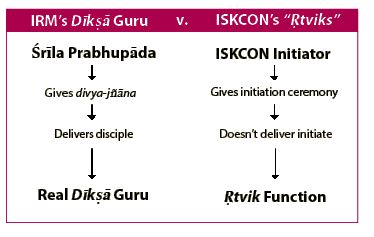
Back To Prabhupäda, Issue 37, Autumn 2012
n the last issue we presented a diagram summarising the evidence from many previous BTP issues ("ISKCON's Rtvik System Summarised"). This diagram showed that ISKCON's supposed initiating gurus actually end up functioning at best as default åtviks (those who just conduct the initiation ceremony) who merely pretend to be dékñä gurus. In contrast, the system of accepting Çréla Prabhupäda as the dékñä guru was the standard system of initiation in ISKCON before Çréla Prabhupäda's physical departure, and all sides accept that it was bona fide. And the IRM simply proposes that this system continues. Under this system, many disciples never met Çréla Prabhupäda either before, during or after initiation. The characteristics of such a dékñä guru system are detailed below.
Accepting Çréla Prabhupäda as one's dékñä guru is the acceptance of the personality who, through his spiritual teachings provides the transcendental knowledge, or divya-jïäna, which is dékñä:
"dékñä actually means initiating a disciple with transcendental knowledge by which he becomes freed from all material contamination."
(Çré Caitanya-caritämåta, Madhya-lélä, 4:111)
"dékñä, dékñä. Di... Divya. There are two words, divya-jïäna. Divya-jïäna means transcendental, spiritual knowledge."
(Çréla Prabhupäda Lecture, 22/2/1973)
Whereas, the GBC-elected ISKCON initiators, as explained on page 6 of this issue, admit to hardly providing any knowledge; directing their disciples instead to read Çréla Prabhupäda's books.
Accepting Çréla Prabhupäda as the dékñä guru means accepting the dékñä guru as directed by çästra (scripture) - one who is in the paramparä (disciplic succession), does not fall down and always remains in the paramparä:
"A bona fide spiritual master is in the disciplic succession from time eternal, and he does not deviate at all from the instructions of the Supreme Lord".
(Bhagavad-gétä As It Is, 4:42)
The GBC-elected ISKCON initiators, however, frequently do fall down, and, as evidenced in last issue's diagram, do not even need to be in the paramparä.
Accepting Çréla Prabhupäda as the dékñä guru means accepting the dékñä guru as directed by çästra - one who is on the topmost level of Kåñëa consciousness:
"When one has attained the topmost position of mahä-bhägavata, he is to be accepted as a guru and worshipped exactly like Hari, the Personality of Godhead. Only such a person is eligible to occupy the post of a guru."
(Çré Caitanya-caritämåta, Madhya-lélä, 24:330)
The GBC-elected ISKCON initiators, meanwhile, have been declared to not be situated on this level by ISKCON's sannyäsa minister, who accepts that none are "completely aware of the Supersoul". ('Duties of GBC and Guru in ISKCON', 2006, & email: 30/8/2006, Prahlädänanda Swami)
A consequence of the qualification standard just stated is that Çréla Prabhupäda is always carrying the Lord within his heart, whereas the GBC-elected ISKCON initiators are not - which means that Çréla Prabhupäda is the right person to be initiated by:
"Unless one is initiated by the right person, who always carries within his heart the Supreme Personality of Godhead, one cannot acquire the power to carry the Supreme Godhead within the core of one's own heart."
(Çrémad-Bhägavatam, 10:2:18)

Accepting Çréla Prabhupäda as the dékñä guru means accepting the dékñä guru as directed by çästra - the personality who actually delivers the disciple. Whereas, in the last issue's summary diagram, we presented evidence showing how the GBC-elected ISKCON initiators themselves have admitted that it is Çréla Prabhupäda, and not themselves, who delivers their "disciples":
"The spiritual master initiates the disciple to deliver him, and if the disciple executes the order of the spiritual master and does not offend other vaiñëavas, his path is clear."
(Çré Caitanya-caritämåta, Madhya-lélä, 1:218)
All of the above demonstrate that accepting Çréla Prabhupäda as the dékñä guru is driven by the standard idea of who should be accepted as one's dékñä guru - a fact that even ISKCON acknowledges:
"the "zonal äcärya" system and the "posthumous åtvik" system - rest on adherence to the traditional idea of leadership."
(Allegiance to Guru, to ISKCON and to Prabhupäda, Ravindra-svarüpa Däsa, 1998)
In contrast, ISKCON's current system, as documented in last issue's summary diagram, consists of de facto åtviks "pretending" to be dékñä gurus. This charade is not taught by Çréla Prabhupäda or any scripture, and is therefore non-standard and a concoction.
The debate over the guru issue between the GBC and the IRM has been framed by the former as being one of "dékñä v. åtvik". Indeed, one ISKCON guru, Dänavér Goswami, has even titled his paper, which specifically addresses the issue, as "Dékñä or åtvik" (answered here: www.iskconirm.com/danavir.htm). This paper claims that the GBC are advocating the system of dékñä guru in opposition to a åtvik system which "eliminates the dékñä guru". However, the facts presented above, together with the evidence from previous issues, leads to a startling conclusion that turns the debate between the IRM and the current GBC completely on its head. Thus, it is the GBC, and not the IRM, who are proposing a system of åtviks pretending to be dékñä gurus, instead of real dékñä gurus; and it is the IRM, and not the GBC, who are proposing a standard dékñä guru system, with a real dékñä guru! (See diagram above). Therefore, if the GBC want to prohibit "åtvikväda" from ISKCON, they actually need to prohibit their de facto åtviks from masquerading as dékñä gurus and instead promote the real dékñä guru, Çréla Prabhupäda! So devotees need to choose:
Çréla Prabhupäda or
the åtviks (ISKCON gurus)?!
Return to IRM Homepage